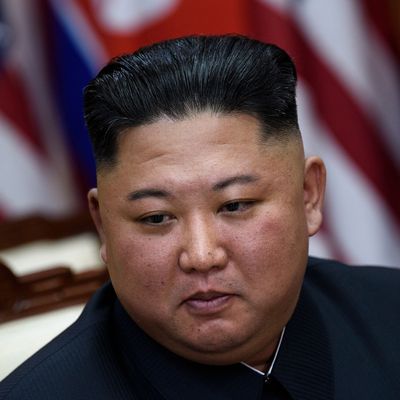
In North Korea, rumors about the demise of the country’s leaders are a national tradition. The Quincy Institute’s Jessica Lee recalls that, in 2008, a “self-proclaimed North Korea expert said that Kim Jong Il [had] died from diabetes in 2003,” five years earlier, “and that a double was running the country.” (He actually died in 2011.) In 2014, Kim Jong-un mysteriously vanished from state media for six weeks before reappearing with a cane, after what the North Korean government said was surgery to remove an ankle cyst.
Now it’s happening again: no one’s seen Kim Jong-un since April 11, and it’s anyone’s guess as to what’s become of him.
Various sources have reported very different realities. An adviser to South Korea’s president assured Fox News that “Kim Jong-un is alive and well”; Japanese media claimed to have been told by a member of a Chinese medical mission that Kim is in a “vegetative state” after “clutching his chest and falling to the ground”; U.S. intelligence agencies say they’ve seen no signs of panic or unusual movements among North Korean elites that might signal the kickoff of a succession battle; President Trump cryptically asserted that “he has a good idea” about the state of Kim Jong-un’s health but “can’t talk about it.” Let’s just hope his good idea doesn’t involve bleach.
The North Korean government has released statements from Kim, congratulating South Africa on its national day and thanking the country’s workers — but has included no photos of its leader. Washington Post North Korea watcher Anna Fifeld speculates that this means he is “still in charge but not camera-ready.”
Although coverage of the rumors has been filled with speculation about instability and violence, experts point out that past transitions have tended to be quiet, at least to the outside world. After Kim Il Sung died in 1994, the regime continued negotiating with the United States over what became the Agreed Framework — although that deal broke down under the new government fairly quickly. When Kim’s son and successor, Kim Jong Il, died nine years ago, many outsiders predicted that his son, the young new leader, Kim Jong-un, would have trouble holding on to power. Whatever internal bloodletting happened — and there are plenty of stories that appear true and plenty of others that turned out to be fakes — the situation did not really ripple out to the rest of the world. Experts guess the same would hold true now — though business as usual would still mean that Pyongyang’s scientists continue to grow its nuclear arsenal, improve its missiles, and manufacture warheads to put on them.
Some analysts have been wringing their hands because Kim Jong-un’s most obvious family successor is a woman, his younger sister Kim Yo-jong. But it’s not an X chromosome that is most likely to destabilize the North. It’s a virus.
COVID-19 is the wild card — both because it’s possible Kim has been ill with it, and because the regime’s neighbors are terrified of an epidemic overwhelming the North’s meager medical facilities. As deaths mounted in China and South Korea last month, Pyongyang claimed, improbably, to have no cases. But the government confined foreigners to their houses, and many later opted to leave the country. Analysts and reporters have speculated about outbreaks in the military or detention centers. Morbidly, intelligence analysts are watching for mass graves, visible from the air, that the regime would use if large numbers of victims overwhelmed crematoriums.
But the health status of the North Korean public is just about as unknown as that of Kim Jong-un. Peter Hayes, the head of Australia’s Nautilus Institute and a multiple-time visitor to the country, wrote in an email that the country is “a global pandemic black box, the opacity of which threatens everyone, not just the Korean nation.” Its neighbors, especially China and South Korea, fear re-infection from the traders and refugees who do cross its borders; there are worries about how the North Korean chain of command would hold up, Kim Jong-un’s condition aside, if coronavirus infections rose the ranks. And then there is the problem of famine. With many workers quarantined, the already-weak economy is grinding toward zero. That creates a possible cycle of infection, hunger and instability, each reinforcing the other.
If Kim Jong-un really is dead, past experience tells us that the regime will likely find a way to carry on. But the coronavirus presents a new kind of challenge for the desperately poor country — one that it may have much more difficulty meeting.





























